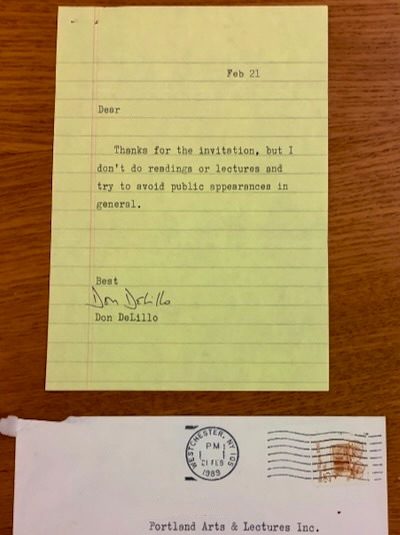
DeLillo reply to invite from Portland Arts and Lectures, Feb. 21, 1989
This page, as is hopefully obvious, contains various references to DeLillo that have been uncovered in some likely and some unlikely places. Most recent findings on top.
In part spurred on by the Beller revisit, novelist Ed Park has posted a talk he gave in April 2017 at the NYC New School DeLillo conference. “It's Raining Now”: Don DeLillo and the Comic Novel, posted on Substack on Aug.25, 2025:
It's a point of interest for me — DeLillo's central characters are by and large white males, and it comes as something of a surprise, to be honest, that his humor is not at the expense of minorities. In a way this is so rare, it's almost the exception to the rule. I would never deny Evelyn Waugh's gifts as a humorist, but it’s hard for me to get through a book like Scoop, where the prejudices are right out in the open; in this sense, DeLillo's early books have aged very well, the jokes, the comic situations, retain their purity — this sounds clinical, but the humor feels language-driven. Reading Americana 20 years after it was published and now — God help me — 45 years after it was published, it seems totally fresh.
(Aug 25, 2025)
If you scroll down a bit you'll find reference to a 2016 New Yorker piece by Thomas Beller entitled "Don DeLillo and Move-in Day". Some 9 years have passed and now he's helping his daughter move for college. The Don DeLillo and Move-In Day, Revisited, posted on Substack Aug 23, 2025, includes this:
What strikes me about White Noise, the novel, from my current vantage is the narrator's sensitivity to his fourteen year old teenage son, and his desire for secrecy and private space. When I think of it now, I think of how much more private space my fourteen year old son will have when his older sister is not in the house. I can’t imagine it. Soon, I won't have to. The treatment of the son might be Delillo's most impressive imaginative act in White Noise, even beyond the formulations in the book that have achieved nearly Catch-22 levels of cultural relevance: "Airborne Toxic Event," most of all. Honorable mention to "The Most Photographed Barn In The World."
(Aug 25, 2025)
When in Oslo recently I picked up the second volume of Karl Ove Knausgaard's My Struggle series for train and plane reading. This one came out in 2009, and covers his initial years having moved to Stockholm and starting a new relationship and family. On several occasions he relates going to a bookstore and picking up a stack, and toward the end of the book in early 2005, he includes the latest DeLillo... (presumably Cosmopolis)
The DeLillo I regretted buying the instant I was outside because even though I had been a fan of his, especially the novels The Names and White Noise, I hadn't been able to read more than half of Underworld, and since the next book has been terrible it was evident he was in decline.
For context, the other books in his stack that day: "a book about Nazi Germany, the first two volumes of Das Kapital, Orwell's 1984, which I had never managed to read, a collection of essays by the same author, a book about Céline".
(July 14, 2025)
I happened to give a listen to Marc Maron's WTF podcast episode with David Cronenberg, which you can find here: WTF episode 1638 - April 28, 2025. In his intro, Marc talks about enjoying the Cosmopolis film, and says the following at about 3 minutes in:
I'm like a Don DeLillo guy, I kinda lost touch with Don after the 9/11 book ... but early on I read all his books, I was obsessed with Libra, I was obsessed with White Noise, Great Jones Street, Ratner's Star, I mean they were great books. He's got a very specific tone, and when I watched Cosmopolis, which is based on a DeLillo novel, I was like, oh my god it's all DeLillo language and made me miss reading DeLillo.
(May 5, 2025)
It's rather old news now, but I had meant to include something about the Emma Cline story 'White Noise' that appeared in The New Yorker on June 1, 2020. The young author offers Harvey Weinstein worrying about his case, sharing morning greetings with his neighbor Don DeLillo, and cheered up by thinking about new a film project.
Harvey could visualize the plan, see each step of the process, the whole thing unfolding cleanly in his mind’s eye without any hiccups or stutters. “White Noise,” the unfilmable book. Harvey’s comeback. Why would he find himself here, on this earth, in the year 2020, if not for this exact purpose?Did DeLillo pen a script for Amazons?The rights were available—Nancy found out in two minutes. Of course they were, because everything would go smoothly this time. His head was spinning. He’d seen attempts, back in the day. Recalled a script for that weirdo hockey novel Don DeLillo wrote under a pseudonym, another script kicking around for the football book. Hadn’t Rudin had the rights, for a hot minute?
What was that first line? He tried to remember. A screaming comes across the sky! A screaming. Beautiful. Vicious. A great first line.
(Aug 14, 2024)

I recently came across an Oregonian article from 2015 which describes a set of responses from various authors to invites from Portland Literary Arts to come to Portland to speak. Don DeLillo's 1989 response is quoted - "Thanks for the invitation, but I don't do readings or lectures and try to avoid public appearances in general." - and now we have the letter itself (note: I've removed the name of the correspondent). He reluctantly changed his policy fairly soon after. Thanks to Rachael for digging in the archive!
(July 25, 2024)
A "graphic review' of White Noise, by Jason Adam Katzenstein appeared in the New York Times Book Review on Feb. 6, 2022. J.A.K. shares his "paranoid kinship" from Los Angeles.
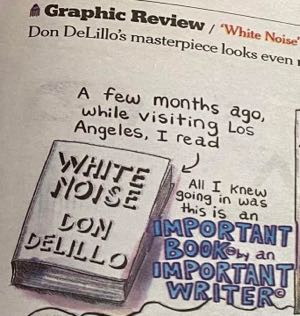
(April 30, 2022)
We know author David Mitchell has a thing for a particular DeLillo line from Americana: "It is so much simpler to bury reality than it is to dispose of dreams." (refer to item below for more details). Somewhat surprisingly the line appears in the late 2021 film The Matrix Resurrections as graffiti in a toilet stall - after a shot of Neo/Thomas Anderson on the can, it's what he sees in front of him, on screen barely long enough to read. The source became clear when the screenwriting credits were shown - Lana Wachowski, David Mitchell and Aleksandar Hemon.
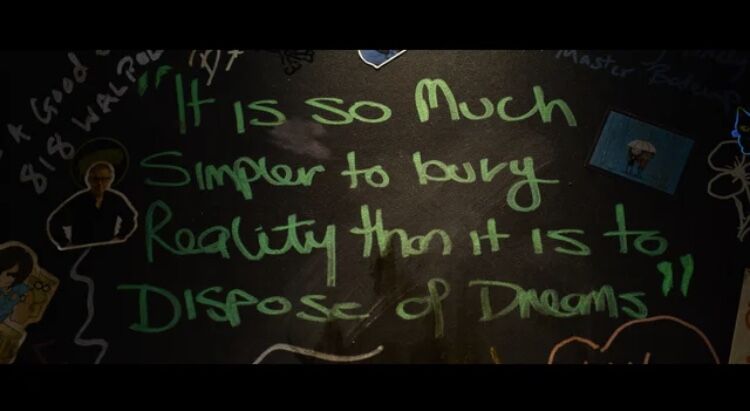
FYI the line is from page 345 of the original Americana hardcover, or page 334 in more recent editions.
(Jan. 1, 2022)
DeLillo is a fan of author Joy Williams, and a friend as well. From a collection of Joy Williams materials held at Washington University, a typed letter from April 2020 from DeLillo to Joy Williams is posted. He mentions that he's finishing what became The Silence, and mentions a couple of books by Robert Walser that Williams apparently was looking for. The description says "DeLillo might have the most pieces of correspondence in Williams’ papers." You can see for yourself on this Washington University Digital Image Collections & Exhibitions page (via the Wayback Machine).
(Jan. 1, 2022)
Belatedly following up on further reports about Netflix projects based on the DeLillo novels Underworld and The Silence. This report by Dan Sheehan from LitHub on Sept. 14, 2021 gives the details: "The Netflix-Don DeLillo romance continues with Underworld.:
Producer and apparent DeLillo Superfan Uri Singer, emboldened by his White Noise acquisition, bought up the rights to DeLillo’s most recent novel, 2020’s The Silence.
Now Deadline reports that Singer, like a crazed Pokémon collector, has acquired the film rights to yet another DeLillo novel, and this time it’s the big one: Underworld.
We'll see if all these get to the finish line...
(Dec. 27, 2021)
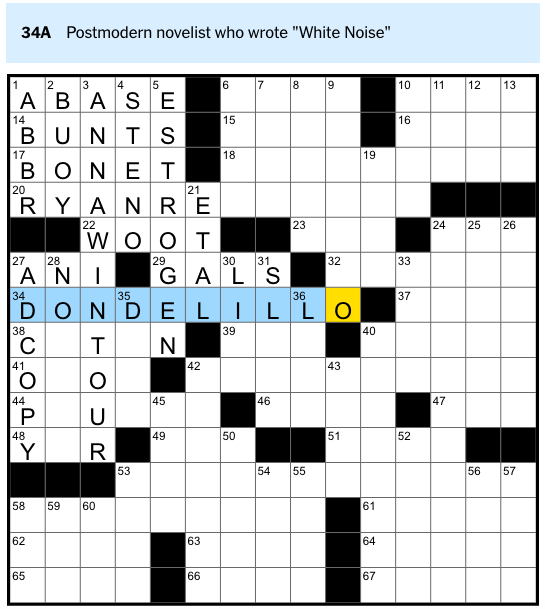
Yes, that's right, 'DONDELILLO' appeared as an answer in the New York Times crossword puzzle on April 21, 2021. Previously 'DELILLO' had appeared, but this time it's for real!
(Posted Aug 29, 2021)
Reports came out this week about a Netflix film project based on White Noise; one story is here from the Los Angeles Times by Julia Barajas, and the Jan. 14 headline pretty much sums it up: "Noah Baumbach will adapt DeLillo’s White Noise; Adam Driver and Greta Gerwig to star:
Baumbach has been nominated twice for the Academy Award for original screenplay — for "The Squid and the Whale" (2005) and "Marriage Story" (2019), both of which explore the intricacies of divorce and both of which he also directed. Gerwig, Baumbach's partner, has been nominated for screenplays of "Little Women" and "Lady Bird" — with the latter also earning her an Academy nod for director. Driver was nominated for best actor in "Marriage Story."
See the White Noise film page for more details.
(Jan. 18, 2021)
Came across an interesting piece on what can't be found on the web with regard to DeLillo's work - and it just so happens to mention this website as a 'potential event' of latent history. The essay is by Mark L. Sample and is entitled 'Unseen and Unremarked On: Don DeLillo and the Failure of the Digital Humanities', one chapter from a collection entitled Debates in the Digital Humanities published in 2012:
Like Don DeLillo’s professor of latent history, presented only half-mockingly in Great Jones Street, DeLillo's third novel—and perhaps his most Pynchonesque, a meditation upon language, celebrity, and paranoia—let us consider the unchronicled and potential events of DeLillo’s own publishing history, the events that remain unseen and unremarked on. Unseen and unremarked on by literary scholars and humanists in general but, more to the point, unseen and unremarked on by the digital humanities.That is, what have the digital humanities failed to notice about Don DeLillo?
Or, to broaden the question and absolve the humanities of any wrongdoing, in what ways has the digital age left behind scholars of DeLillo’s work?
(May 16, 2020)
White Noise in particular is getting quite a few mentions in 2020 in reaction to the coronavirus and lockdown. Here's one piece by Daniel Maurer at Bedford+Bowery 'Tuning Into Don DeLillo's White Noise in This Static Age':
During the airborne toxic event, leadership is mostly absent (at one point, the governor is rumored to have died in a helicopter crash) and it's evident that more could've been done to warn citizens. Even before the chemical cloud, schoolchildren were getting headaches and eye irritations. At the time, investigators — one of whom was rumored to have collapsed and died — unhelpfully attributed this to any number of potential contaminates in the school building: it could’ve been the insulation, the cafeteria food, “or perhaps something deeper, finer-grained, more closely woven into the basic state of things.”
(May 1, 2020)
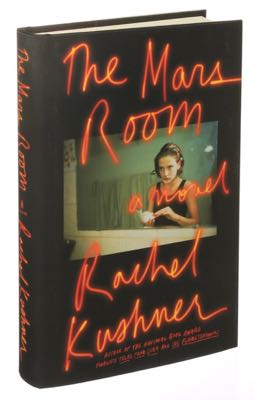
In an interview with The San Francisco Chronicle, Rachel Kushner explains that Don DeLillo helped name her recently published novel The Mars Room. The story is by Jessica Zack, ran May 14, 2018, and is found here with title 'Author Rachel Kushner asks big questions in a tiny space in "The Mars Room"':
Don DeLillo has been a mentor to me. He actually came up with the idea to title the book “The Mars Room.” I didn’t think of it because to me it only indicated this seedy club on Market Street, but he saw it's more about these two words. “Mars” is the god of war and a far-away planet, and “room” is this small, confined space. There’s an interesting tension. Then my husband looked it up and found that the only existing Mars Room is in the Palace of Versailles. It has incredibly violent frescoes on the walls and ceiling. So, why not?
(May 16, 2018)
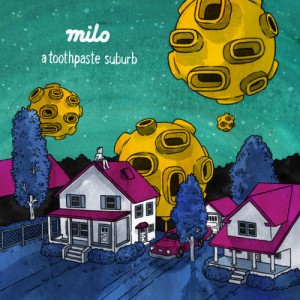
Milo is a young rapper with a 2014 album titled 'A Toothpaste Suburb', taken from a phrase in Cosmopolis. He explains the reference in an interview with KCOU.fm: 'An evening with Milo':
But I guess a toothpaste suburb, in a very literal sense, is from a Don DeLillo novel called Cosmopolis, which is a really shitty Robert Pattinson movie now which you shouldn't watch, but you should READ Cosmopolis. It's about this dude who's like so powerful in the business world, that he doesn’t really even have a home. He just lives in a limousine and he just gets driven around New York all day, and he just makes these billion dollar decisions. And he's like crazy smart, and it's just his life. And at one point he's like on a highway and he pulls over from his like crazy mobile command center, and he just starts shitting on this view that he sees and he calls it a "toothpaste suburb". And I was just like, that's me, you know? Like, I'm the one on the receiving end of that guy's gaze.The line is actually from the second page of the book, where the character is still in his high-rise condo, but the point stands.
(Mar. 18, 2018)
Mark O'Connell's 2017 book To Be a Machine features an epigraph from White Noise. The book's subtitle is "Adventures Among Cyborgs, Utopians, Hackers, and the Futurists Solving the Modest Problem of Death" and features a visit to the Arizona headquarters of Alcor, 1-877-GO-ALCOR. It's a frequently cited bit from Murray Jay Siskind in Chapter 37:
This is the whole point of technology.
It creates an appetite for immortality on the one hand.
It threatens universal extinction on the other.
Technology is lust removed from nature.
-Don DeLillo, White Noise
Jack responds, "It is?"
(Nov. 26, 2017)
La Lettura published a translation of DeLillo's recent story "The Itch" in September 2017, translated by Maria Sepa. Here is an article that touches upon the story, DeLillo, and other literary topics: Don DeLillo and America's Itch from Sept. 17, 2017.
(Nov. 26, 2017)
The Guardian reports on a new effort to get White Noise on the big screen. Alan Evans filed this story Don DeLillo's White Noise to be adapted for film back on Oct 18, 2016.
Don DeLillo’s novel White Noise is to be adapted for the big screen by Michael Almereyda, the writer-director best known for Hamlet and Experimenter.Almereyda will adapt and direct the story of Jack Gladney, a professor of Hitler studies in a fictional midwestern town in the US, who is forced to confront his fear of death when a train carriage derails nearby, releasing a poisonous chemical cloud that hovers over his town.
(March 18, 2017)
La Stampa ran a short interview with DeLillo by Paul Mastrolilli on the occasion of Bob Dylan being awarded the Nobel Prize for Literature, which ran on Oct 14, 2016. With some help from Google Translate:
Q: It does that seem fair to give the Nobel Prize for literature to a singer?
A: "Absolutely, in this decision there is nothing that is a problem for me. I listen to Bob Dylan music for decades, and I think he's always been a great artist."
(Oct 15, 2016)
Thomas Beller has a piece in The New Yorker entitled "Don DeLillo and Move-in Day" which ran on Sept 6, 2016. He muses a bit on the opening of White Noise:
It's that last line, about the insurance coverage, that has stayed with me. It's like a weapon of contempt that, simply by reading it, one gets to pick up and handle. The book proceeds to veer into domestic comedy, a satire of academic life, and finally to "The Airborne Toxic Event," for which it is famous. But something about this opening pierced me and I always think of it, which is odd, because, although I had a liberal-arts-college experience with the same trappings as described on that first page, my father died when I was quite young. There was no man to send me off, massively insured or otherwise. Maybe that is why I found the low-grade contempt smuggled into those lines so satisfying; they mock the dads' delusion that the worst can be guarded against, mitigated, or hedged.
(Sept 19, 2016)
A nice blog post from New Republic by Alex Shephard tells us that Don DeLillo isn't on Twitter and will never be on Twitter and I think that's a good bet. He does reveal the DeLillo-related Twitter account you should follow.
(Sept 5, 2016)
The journal Orbit: Writing Around Pynchon has come out with a special issue on Don DeLillo. Articles include "The Work of Don DeLillo in David Foster Wallace's Infinite Jest: by Graham Foster, "Death and Metafiction: On the 'Ingenious Architecture' of Point Omega" by Brian Chappell, "'Freud is finished, Einstein's next': Don DeLillo's Cosmopolis, Chaos Theory, and Quantum Entanglement" by Crystal Alberts, and several more.
(June 7, 2016)
Don DeLillo dropped into a swirl of uproar based on a New York Times story on Obama aide Ben Rhodes, entitled "The aspiring Novelist Who Became Obama's Foreign-Policy Guru" by David Samuels dated May 5, 2016. Here's the DeLillo bit:
"What novel is this that you are living in now and will exit from in eight months and be like, 'Oh, my God'?" I ask him."Who would be the author of this novel?" he asks.
"The one you are a character in now?"
"Don DeLillo, I think," Rhodes answers. "I don’t know how you feel about Don DeLillo."
"I love Don DeLillo," I answer.
"Yeah," Rhodes answers. "That’s the only person I can think of who has confronted these questions of, you know, the individual who finds himself negotiating both vast currents of history and a very specific kind of power dynamics. That's his milieu. And that's what it's like to work in the U.S. foreign-policy apparatus in 2016."
(May 9, 2016)
A film production of The Body Artist is apparently in the works in France. See this les inRockuptibles story "Benoît Jacquot va adapter The Body Artist" by Léo Moser dated September 28, 2015. Will have to keep an eye on progress.
The film was indeed made and released in 2016: 'Never Ever'.
(April 6, 2016)
Seems like I can't ignore Garth Risk Hallberg even if I might like to. Hallberg made a big splash with the publication of his long 70s NYC novel City on Fire that was fueled by a big advance (sounds like "Rosalita"!). He's quoted as saying: “My goal was to get the book somewhere that is going to allow me to be DeLillo 40 years from now.” He seems to be on quite a different trajectory. Funny connection is that film producer Scott Rudin bought film rights to Hallberg's book on first glance, setting up big expectations - and Rudin also bought rights to Underworld and White Noise at previous times. See this Vulture story "The Unprecedented Garth Risk Hallberg" by Boris Kachka dated October 5, 2015.
(October 21, 2015)
Marking the 30th anniversary of the publication of the novel, Pitchfork ran a piece by Jazz Monroe titled "No One Sees the Barn: Musicians Discuss Don DeLillo's White Noise" on Jan. 20, 2015. Included are several book-reading folks from bands including Vampire Weekend and Parquet Courts, and I liked this bit from Arto Lindsay:
I actually had a chance to meet him a couple of years ago. I was on the jury of this little film festival in Portugal - he goes pretty much every year because he loves movies and they pay for him to go over there. He's a really cool, low-key guy. Paul Auster was also there, talking about the movie stars he had breakfast with. DeLillo is not at all taken with that. His wife is a birdwatcher. They're just people. He's very down to Earth, very Bronx. They're older, they have a bit of retired couple thing. He's a little bit like one of his characters at this point.
(May 15, 2015)
Thanks to André, this fun story: The Art-Borne Publishing Event: Karma, Glenn Horowitz to Publish Obscure DeLillo Play by Dan Duray on April 2, 2014 in The New York Observer.
In a phone call, Mr. Horowitz said he’s done business with Mr. DeLillo for 10 years, recently helping him sell his papers to the University of Texas. Not long ago, he inquired if Mr. DeLillo might have anything in the archives worth publishing.
"Without any arm twisting, Don responded by offering me this text that had never been seen," Mr. Horowitz said. "In typical DeLillo fashion, he probably also said it didn’t deserve to see the light of day but that I’m welcome to do anything with it."
(Oct. 30, 2014)
At The Atlantic, Megan Garber crafted a funny item in reference to the pop singer's release of 'Track 3' which turned out to be eight seconds of silence: The Author of White Noise Reviews Taylor Swift's White Noise. Sound actually is a big concern of White Noise. "It is the time of year, the time of day, for a small insistent sadness to pass into the texture of things. Dusk, silence, iron chill. Something lonely in the bone."
(Oct. 27, 2014)
In his photography book CRUSHED from 2003, the epigraph is from Emmett Creed - "It's only a game, but it's the only game." Here's a link to CRUSHED. You can figure out where that comes from.
(June 5, 2013)
In the recently published Letters of William Gaddis (Dalkey Archives, 2013) there's a 1988 letter to DeLillo upon the publication of Libra (reported in the Daily Beast). Here's a piece of it:
...the hard cover arrived here a couple of weeks ago & I’ve just read it & confirmed all my earlier impression, its marriage of style & content—that essential I used to bray about to ‘students’ in those grim days—is marvelously illustrated here I think & especially as it comes together at the end as we know it must, speaking of the ‘nonfiction’ novel if we must but why must we, except that concept does embrace the American writer’s historic obsession getting the facts down clear...
(March 15, 2013)
In James Wolcott's recent memoir Lucking Out (2011) of his time in New York City in the mid-seventies, he devotes a paragraph to DeLillo (p. 244-45). Here's most of it:
In recent years DeLillo must ask himself the cosmic question, "Why go on?," his later novels greeted with a fish-face without a trace of affection for everything he's done before, beating him up with his own achievements (Libra, Underworld) instead. His Great Jones Street of 1973 doesn't have the cybernetic density and conspiratorial mesh of his corporate-gnostic-algorithmic probes into power, chance, and paranoia, but its hungover mood evokes the exhaustion and pissed-away promises of the post-sixties, a psychological dehydration requiring a sequestering with none of the skin tingle of A Sport and a Pastime's incognito air. I know, sounds like fun.... And yet its sense of time and place (I love that the novel is named for and set in an actual street with no mythic overtones until DeLillo endowed them) hooks me each time out.... I sometimes wonder if Great Jones Street might not be more highly esteeemed if DeLillo hadn't dubbed his rock-star narrator Bucky Wunderlick, a Pynchonesque moniker that's hard to take seriously for a mystique-ridden Jim Morrison-like lizard king in self-exile.
(Dec. 10, 2011)
Last year The New Yorker presented a recording of Chang-rae Lee reading DeLillo's 2002 story "Baader-Meinhof", and you can listen to it right here: Chang-rae Lee reads DeLillo. The recording includes a short intro segment with Lee talking with the fiction editor Deborah Treisman, and some discussion of the story afterward. Lee mentions reading White Noise in college, and then later digging into the catalog and being "overtaken" by DeLillo.
(Mar. 28, 2011)
A post on the blog A Piece of Monologue displays a set of cover images for DeLillo editions coming out in March 2011 (I think in the UK). Here's a sample:
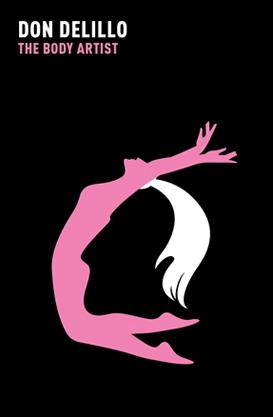
You can see more of the new covers as well as read a few comments from the designer of these covers, Noma Bar, at this post at Creative Review. Here's one more I especially like:

(Nov. 18, 2010 & Mar. 28, 2011)
In the August 13, 2010 issue of the Times Literary Supplement included a funny bit on DeLillo interviews in the NB column "Talking it over" by J.C., page 32. Here's a piece:
It appears that DeLillo does want to talk about it. But what is it? In a perfect subversion of the reluctant-interviewee narrative, what DeLillo wishes to talk about is the fiction that he is unwilling to be interviewed.
(Nov. 18, 2010)
William Wood has a piece in The Point on "Don DeLillo" (not sure when it originally appeared). He mostly discusses Point Omega and Americana. Here's a piece:
Given these considerations, a plea for the enduring importance of DeLillo's work can profitably focus on Americana, his first novel. Although DeLillo considers himself to have reached maturity only with White Noise, Americana shows a writer having already perfected his voice at its inception. The author's departure in Americana from traditional tropes of plot, character development and so on bears witness that the essence of traditional formal conventions was not the extrinsic form itself but the underlying pathetic dynamic they successfully sustained. Critique of this departure is therefore as irrelevant as would be a critique of modern theater on account of its virtually ubiquitous disregard for the Aristotelian unities of place, time and action. Holding the novel together is DeLillo's forging of a unified effect of language from the formal contradictions of his situation as a writer; those prominent in their partial resolution include the problem of the alternate banality and poetry of both vernacular and self- consciously literary styles.
(August 27, 2010)
Tom LeClair's piece "The Artist Pursued" in The Barnes & Noble Review (posted July 27, 2010) on interviewing novelists (or not) touches upon DeLillo among others. Here's a piece:
DeLillo, the man who didn't want to talk about it, somewhat improbably understands things an interviewer can do for a writer. In Point Omega the interviewer listens without objection to the blowsy, self-serving monologues of the aging writer, and when his daughter disappears in the desert it's the young interviewer who helps organize the search and cares for the despairing father. Yes, it's possible the interviewer's sexual interest in the young woman drove her into the desert, but I don't think that was the interviewer's intention. In the end DeLillo's filmmaker, like Kehlmann's journalist and Bolaño's professors, loses the interview. I'm not suggesting this is equivalent to losing one's daughter, just noting that the interviewer's good works go unrewarded.
(August 10, 2010)
Author David Mitchell has made reference to DeLillo a few times, first in an epigraph to his second novel, Number9Dream (2001), with the line "It is so much simpler to bury reality than it is to dispose with dreams" from Americana.
In the most recent issue of The Paris Review (Summer 2010, #193), the Art of Fiction interview with Mitchell asks about the epigraph. Mitchell replies "The best line in the book and it's not even mine." Followed by this exchange:
Interviewer: It's pretty obvious what that has to do with your hero, Eiji, an inveterate fantasist who dreams of a father he has never met - but is there a deeper link between Number9Dream and DeLillo?Mitchell: I read Underworld around that time, and was deeply impressed by it, which led me to Mao II, and Americana, which is where the epigraph is from - but I don't think there's a deeper link between our writing. DeLillo is more of an ideas man than me - than just about any novelist I know, for that matter.
(July 17, 2010)
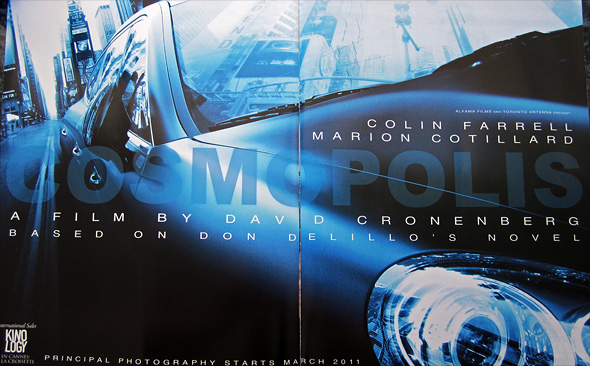
Last July was the first news that David Cronenberg was involved with a Cosmopolis project. Yesterday news broke that Colin Farrell and Marion Cotillard are "attached" to the project. Here's the Variety story, with excerpt:
Farrell will play a millionaire Manhattan asset manager who loses all his wealth over the course of one day. Cotillard will play his wife.
Filming tentatively scheduled for March to May, 2011 in Toronto and New York.
(May 13, 2010)
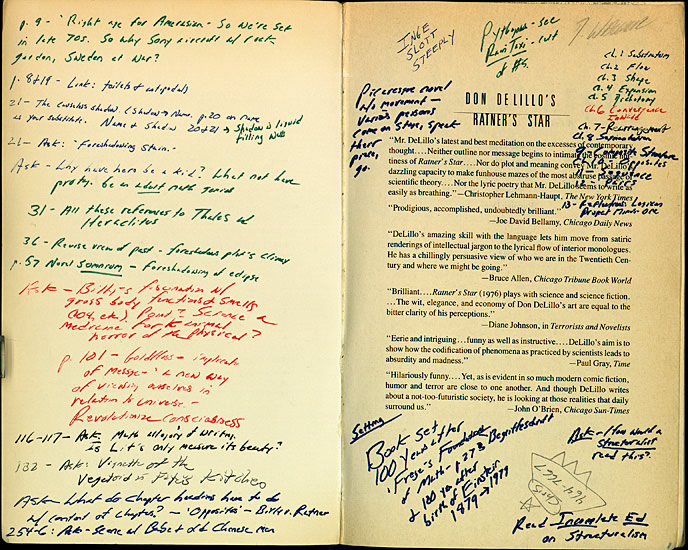
Joining the DeLillo papers, David Foster Wallace's archives have been acquired by the Harry Ransom Center in Austin, Texas. Of some tangential interest to this site are the copies of DeLillo novels with Wallace's notes.
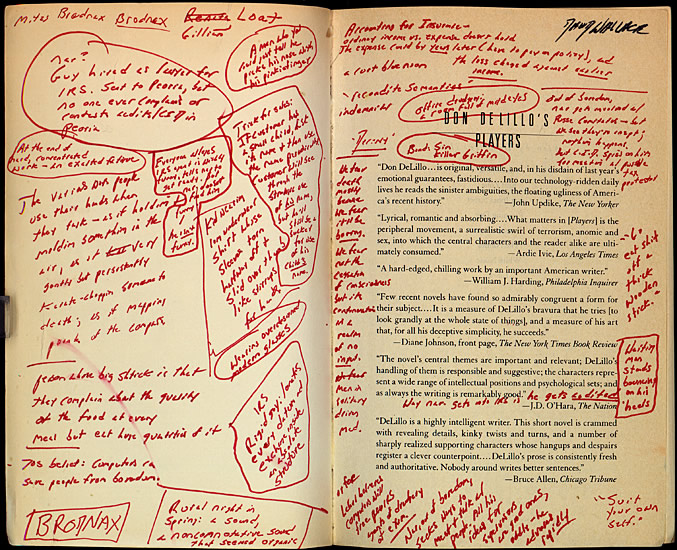
(April 25, 2009)
Slate has a 50 minute discussion of White Noise upon its 25th Anniversary, and the discussion is online. Our critics discuss Don DeLillo's White Noise featuring Stephen Metcalf, Meghan O'Rourke and Troy Patterson. Opinion is sharply divided. I have to say I found Patterson's early statement that the book is "flagrantly bad" to be flagrantly judgemental.
(Feb 23, 2009)
Abe let me know about this recent news report from Italy. DeLilloesque? Decide for yourself!
Italian mafia 'sunk toxic waste'Italian authorities have begun investigating a shipwreck allegedly containing toxic waste off the Calabrian coast, after claims it was deliberately sunk by the mafia.
A former member of the criminal organisation says the vessel and its cargo were blown up in a lucrative radioactive disposal scheme and that the ship contained "nuclear" material.
Investigators have obtained pictures from a robot submarine with a video camera taken at the scene and are now examining samples taken from the wreck.
The Cunsky ship may be one of 32 vessels with toxic material on the Italian seabed, prosecutors said.
An intrepid artist is attempting to draw Every Person in New York, and on Sept 1, 2009 he apparently saw Don DeLillo, looking something like this:

(Sept 18, 2009)
A flurry of stories hit the web yesterday about Canadian film director David Cronenberg getting involved with a project to film Don DeLillo's Cosmopolis. Wendy Mitchell's story at Screen Daily Cronenberg comes on board for DeLillo adaptation Cosmopolis adds the following:
Cronenberg will adapt the screenplay with "a view to eventually direct."There was an earlier Screen Daily post by Geoffrey Macnab from February on Branco's efforts with Cosmopolis, Paolo Branco plots Cosmopolis.Paulo Branco is producing the project through his Alfama Films, in a co-production with Cronenberg's own Toronto Antenna Ltd.
(July 25, 2009)
Mark Sample has uncovered what he calls the 'Littlest Literary Hoax', in a blog post at Sample Reality on July 16, 2009. Here's the scoop:
I am referring to "An Undeniably Controversial and Perhaps Even Repulsive Talent," a review of David Foster Wallace's work that appeared in the prestigious journal Modernism/Modernity, published by The Johns Hopkins University Press. Found in the Volume 11, Number 4 issue (2004) of Modernism/Modernity, the review focuses on Wallace's last collection of short stories, Oblivion, and is attributed to a certain Jay Murray Siskind, Department of Popular Culture, Blacksmith College.Anyone familiar with White Noise should recognize the clues that the supposed reviewer is DeLillo's character and not some real live scholar with the same name: there's the fictional Blacksmith College (which, while not the college portrayed in White Noise, is a name of one of the neighboring towns); there are the fake footnotes in the review referring to other characters and details from White Noise, including narrator Jack Gladney and thuggish Alfonse Stompanato)
The story gets better, as Mark got a reply from the editors of the journal... as he documents in The truth behind Jay Murray Siskind's review of David Foster Wallace, a post from July 19. Lawrence Rainey, editor, and Nicole Devarenne, former editor, 'explain' - here's the first bit:
As the journal's book review editors at the time, we were at first disconcerted to receive an email from Jay Murray Siskind. Our suspicions were heightened when we noted that his email address read "blacksmith.edu," rather than the better known College-on-the-Hill, where Murray was last seen working. But research soon revealed that his change in academic affiliation was the result of a bitter tenure decision fight, in which Alfonse Stompanato had played an especially unsavoury role.All good academic fun, except when some folks end up thinking it's legit!
(July 21, 2009)
In an interview with Powell's Books on June 24, 2009, novelist Colum McCann gives an interesting answer on one of the questions:
Q: If you could have been someone else, who would that be and why?McCann's the author of the recent novel Let the Great World Spin, set in New York City in 1974.A: I teach at Hunter College in New York and recently had Don DeLillo come to class. It was an extraordinary day. He was incredibly profound and moving and gracious and just plain honest with the students. I was also stunned by his humility. At one stage he said to us, "I seem to be the beneficiary of an occasional revelation." This is the man who wrote Underworld, one of the best novels of the last 25 years. We went out afterwards with a couple of students and had dinner, and a few drinks, and I watched him climb into a cab, and I thought that I would like to be that mind, I would like to sit inside that mind, if even just for a while, traveling home to Bronxville on a March night in 2009. I would very much like that indeed, to be going in that direction.
(July 11, 2009)
In this Huffington Post item by Vickie Karp on June 7, 2009, "Lotto Winner Gives Millions to the Arts", lotto winner Cynthia Stafford claims in the interview to be funding development for a film of DeLillo's White Noise.
Third Screen: You are now the executive producer of a major forthcoming film based on Don DeLillo's novel, White Noise, which won the National Book Award in 1985. How did that come about?Stafford's story is explained a bit further in this LA Times story "The Geffen's Lotto Donor" by Karen Wada on December 25, 2008:Stafford: Don Delillo's novel, White Noise, has a strong and really loyal following, and everyone's wanted to see this happen for a long time. The option process was circling for over 20 years before I came along. Don had sort of given up. Another production partner and I secured the option. I'd read the novel. I loved it. I rescued it.
In May 2007 she won $112 million in the multi-state Mega Millions lottery with her father, Robert Stafford Sr., and brother, Robert Stafford Jr. The three divided a lump-sum payment of $67 million.
We'll see what happens!
(July 11, 2009)
Update in 2025: Stafford filed for bankruptcy in 2016.
For those interested in reading DeLillo's pre-Americana work, some good news! The Kenyon Review has published a new anthology of pieces previously published in the journal, and it includes DeLillo's 1966 story "Coming Sun. Mon. Tues." Details here: Readings for Writers.
(July 11, 2009)
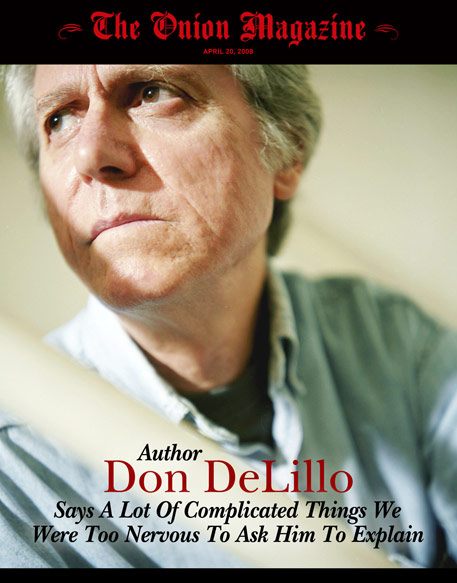
The Onion Magazine cover for April 18, 2008.
It seems The Onion has an ongoing fascination with DeLillo... Sometime in October that started running a 'blog' that purports to be written by the man himself, here billed as a 'Master of Postmodern Literature'. So far there have been three entries: , and 'Tiny Silver Death Machine: Election Coverage 2008' (Sep. 26, 2008), 'Tiny Silver Death Machine: Election Coverage 2008 Part Two' (Sep. 26, 2008), and 'All The Electric Premonition That Rides The Sky Being A Drama Of Human Devising' (Nov. 5, 2008).
I thought I would just ignore it, but I've heard from many people about it, and it seems to be getting attention in various places...
"Don DeLillo Blogging the Election For the Onion: Definitely a Hoax" claims the Village Voice.
But the New Yorker has a strange item that also claims to be from the man, The Final Word posted by one Ligaya Mishan on Oct. 10 (a followup to earlier posts of Oct. 9 and Sep. 30):
Yes, I posted a blog for The Onion, but this was four years ago at the Republican Convention in New York. Evidently the report has been orbiting the blogosphere all this time. Note the prophetic reference to Sarah Palin.
Who's fooling who?
A number of recent news stories have run on the passing of Anna 'Jeanne' Layton at age 77, a Utah librarian who fought back against the censorship of Don DeLillo's first novel 'Americana' in 1979 and temporarily lost her job for it. From the story:
Layton set Utah abuzz and grabbed national headlines in 1979 when she was fired for refusing to pull the titillating novel Americana from the shelves of the Davis County Library.She fought the dismissal and eventually won back her job.
The Davis County Commission labeled the book by Don DeLillo "obscene." But Layton argued that library patrons had a right to choose what they read.
"It's not the library's role to determine choices for adults," she told The Salt Lake Tribune in 1990 as she prepared to retire after 30 years. "It's important for the library to serve everyone in the community, not just select groups."
The full story by Christopher Smart from the Salt Lake Tribune, ran on Jan 23, 2008, Jeanne Layton: Librarian who fought Davis County censorship dies at 77.
(Jan 27, 2008)

Here's a real rarity - a DeLillo candid shot! It was taken by the owner of the Gotham Book Mart, Andreas Brown, at Yankee Stadium, showing DeLillo along with Paul Auster and two Gotham employees. Posted on the FineBooks blog back in May 2007.
News has been trickling out about a project to film End Zone. In summer 2007 a story appeared in Time Out London reporting that "Hartnett enters 'End Zone'", actor Josh Hartnett signing up for the project set to start filming in January 2008 in Texas.
The project is headed up by George Ratliff, and this interview from IFP.org gives some background on him. Interesting note: "Just after attending film school at the University of Texas, Ratliff returned to his hometown of Amarillo, Tex., to make Plutonium Circus (1995), an offbeat look at a nuclear-weapons factory and the community it supports." Here's Ratliff writing the script for End Zone:
I was interested in adapting Don DeLillo's End Zone. I had begged for the rights for two years. I sent DeLillo a spec script, which he liked enough to give me an option. That's when I teamed up with David Gilbert to help me write a much better draft. In the end, we had a great script but had a hard time setting it up.
Ratliff makes mention of the End Zone project in another story on his film "Joshua" that ran in the Boston Globe on July 11, 2007, "His fear really is close to home" by Joel Brown.
Having completed a hot genre picture, Ratliff and Gilbert might be expected to consolidate their gains via a similar film with a slightly higher budget and bigger stars.But no, they're adapting -- gulp -- a Don DeLillo novel, "End Zone."
"This is the DeLillo that people don't know about," Ratliff said. "This is his second novel. It's a very funny football satire, but it's sort of football obsessed with, you know, apocalyptic warfare."
People are always saying how easy it is to film DeLillo, right? Ratliff laughed. "Yeah," he said. "DeLillo is sooo adaptable."
A story in Variety "Hartnett runs to 'End Zone'" on November 8, 2007 seems to confirm that all is set to go on the project. Filming now to commence in February 2008 in New Mexico, and will also star Sam Rockwell.
Update on Sept. 7, 2008: A story on actress Kat Dennings "Dennings revels in her dark side" by Jim Slotek, Toronto Sun (no longer online) indicates that filming never started.
But her dream project, End Zone, has yet to be greenlit."It's based on a Don DeLillo novel and it was supposed to be me, Sam Rockwell and Josh Hartnett. The plot is centred around football but it's really about nuclear war, essentially, so that's why it's hard to sell. It's in the top five best scripts I ever read.
"Although I find usually if I want something too badly, it doesn't work out."
Well, let's hope she backs off a little!
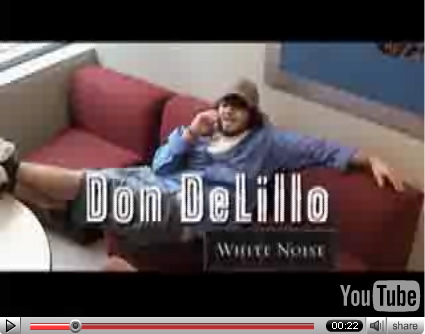
In the old days you could enjoy the video here: http://www.youtube.com/watch?v=laqRHrrp3xo, but now it's gone.
Thanks to Chris for this one.
(Dec. 12, 2006)
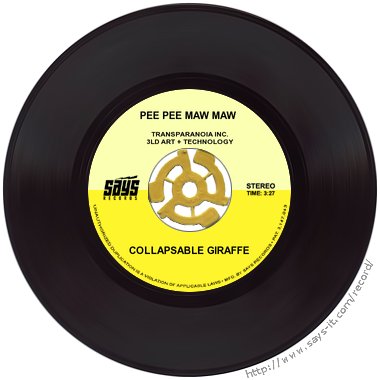
In another multimedia item, a story from Dec. 7, 2006 reports that a New York theater company has been awarded a grant that will be used for a DeLillo-related production. The pertinent info:
The Collapsable Giraffe will use its award to allow costume designer Tara Webb to incorporate wireless video and sound devices into her costumes for their upcoming production Pee Pee Maw Ma, inspired by Don DeLillo's novel Great Jones Street.
The story was found on the TheaterMania website, in a story
titled "A.R.T/New York Awards $67,500 in Design Grants
to NYC Theaters". I asked Collapsable Giraffe for more info, and they
report that the current plan is to put the production up in Fall
2007.
(Dec. 12, 2006)
Acey told me she was at a party and she said to a man, What do men really want from women, and he said, Blowjobs, and she said, You can get that from men.
Hitchens mentions WWII, Deep Throat and better dentistry
as primary causes. Read the piece: "As American as Apple Pie".
(June 26, 2006)
A.O. Scott has written an essay on the results that appears May 21, 2006 called "In Search of the Best"
Like American Pastoral, Underworld is a chronologically fractured story drawn by a powerful nostalgic undertow back to the redolent streets of a postwar Eastern city. Baseball and the atom bomb, J. Edgar Hoover and the science of waste disposal are pulled into its vortex, but whereas Updike and Roth work to establish connection and coherence in the face of time's chaos, DeLillo is an artist of diffusion and dispersal, of implication and missing information.
P.S. It's important to understand how this survey was conducted.
Each of the 125 voters got just a single vote - their pick for
single best work of American fiction. Underworld was chosen
by 11 people, White Noise by 3 or 4 (it's unclear) and
Libra got 2 votes. Beloved was chosen by 15 voters,
and various novels by Philip Roth garnered a total of 21 votes,
with American Pastoral getting the most at 7 votes. I think
that the format of this survey was not fully grasped by many pundits
who complained about the lack of diversity.
(May 19, 2006)
The only disappointment was that the patron he really wanted didn't quite come up with the goods. 'When I was at college, I and half the young men I knew wanted to be Don DeLillo,' he says, when I ask which contemporary writers he does read. 'I sent him a copy of the book, hoping he might give me a blurb. I didn't get one, but he sent me a postcard that just said 'Kunkel? Wasn't there a pitcher for the Yankees named Kunkel?' It's displayed prominently in my apartment.'
Kunkel went to Harvard, and is one of the folks responsible
for n + 1.
(Nov. 21, 2005)
It was as though, in some odd quantum stroke, Hemingway died one day and Pynchon was born the next. One literature bends into another. Pynchon has made American writing a broader and stronger force. He found whispers and apparitions at the edge of modern awareness but did not lessen our sense of the physicality of American prose, the shotgun vigor, the street humor, the body fluids, the put-on.I was writing ads for Sears truck tires when a friend gave me a copy of V. in paperback. I read it and thought, Where did this come from?
The scale of his work, large in geography and unafraid of major subjects, helped us locate our fiction not only in small anonymous corners, human and ever-essential, but out there as well, in the sprawl of high imagination and collective dreams.
(May 26, 2005)
I've rarely read Don DeLillo since the binge years, when I feverishly read and reread every one of his novels, and now, when I do, I find myself stirred but confused. The moment Don DeLillo became in any way fallible to me, I experienced a rupture I'm still traumatized by, one that colors my ability to situate him reasonably in my internal landscape of "contemporary letters" -- he's either as great as I thought he was when I thought he made all other writing look silly or he's a total disaster....
By trying to export myself to a place that didn't fully exist, I was asking works of art to bear my expectation that they could be better than life, that they could redeem life. I asked too much of them: I asked them to also be both safer than life and fuller, a better family. That, they couldn't be. At the depths I'd plumb them, so many perfectly sufficient works fo art became thin, anemic. I sucked the juice out of what I loved until I found myself in a desert, sucking rocks for water.
The was especially true of anything that assumed a posture of minimalism or perfectionism, or of chilly, intellectual grandeur. Hence my rage at Stanley Kubrick, Don DeLillo, Jean-Luc Godard, and Talking Heads.
"Gold Mine Gutted" finds Oberst chasing "Don DeLillo whiskey" with a farewell to the "sorrowful Midwest" as his band whips up a chilly soundtrack that the Cure's Robert Smith could proudly call his own.
The film is described as follows:
Game 6 / U.S.A. (Director: Michael Hoffman; Screenwriter: Don DeLillo) - Combining real and fictional events and centered around the historic 1986 World Series, this is a day-in-the-life snapshot of a playwright who skips his own opening night to watch the momentous game. World Premiere.(December 1, 2004)
The news can be found here, at the City of New York Mayor's Office of Film, Theatre and Broadcasting site, in a report dated August 1, 2004. Here is the pertinent paragraph:
Also choosing New York City as a prime location is director Michael Hoffman, who is shooting "Game 6", starring Michael Keaton and Robert Downey, Jr. The film follows a playwright on the day of the legendary game six of the 1986 World Series between the New York Mets and Boston Red Sox, and is scheduled to shoot through August 11.
I imagine it may be a year or so before it is released.
(September 3, 2004)
Barry Sonnenfeld has teamed with Cherry Road Films on Don DeLillo's White Noise, which he will direct and produce, reports Variety.Stephen Schiff adapted the script for White Noise, winner of the 1985 National Book Award. Sonnenfeld told the trade that casting would begin immediately. He also hopes the project will regain sole claim over its title, which is shared by an upcoming Michael Keaton thriller from Universal Pictures.
The story is a dark comedy in which a professor must contend with a wife who's possibly drug-addled, four kids who are too progressive for anyone's good and a chemical plant that has accidentally released a cloud of potentially lethal gas.
Given the way these things usually go, I wouldn't recommend
holding your breath!
(July 31, 2004)
Singer Rhett Miller (from the Old 97's) name-drops DeLillo on his 2002 solo album, in the song "World Inside the World."
David Bowie has been dropping references to DeLillo lately (summer 2002).
In the Rolling Stone of 8 Aug. 2002, Mim Udovitch's
"Q & A: David Bowie" (p. 30) features the
following exchange.
[DB:] What I'm good at is low-level nagging fear.(thanks to Phil Nel for this one)
[MU:] But of what?
[DB:] My shoes. I mean, they're just not right.
[MU:] Seriously. A fear of what?
[DB:] What did Don DeLillo call it? The hum of anxiety? In one of his novels, he describes the thing that permeates the city. But, you know, it's a thing like that.
Then in the 9 June 2002 New York Times Arts & Leisure section (p. 30) in an article by Jon Pareles entitled David Bowie, 21st Century Entrepreneur, Bowie is talking about a song written prior to Sept. 11th:
"I hope that a writer does have these antennae that pick up on low-level anxiety and all those Don DeLillo resonances within our culture," he said. "But I don't want to say that it was in any way trying to suggest that it was going to happen. It's not like it's something new to me. These are all personal crises, I'm sure, that I manifest in a song format and project into physical situations. You make little stories up about how you feel. It is as simple as that."
(thanks to Craig Brown)
"It is so much simpler to bury reality than it is to dispose of dreams."
David Bowman's This Must Be the Place: The Adventures of Talking Heads in the 20th Century (New York: HarperCollins, 2001) has this on the dedication page: "This history is for my good friends Brian Breger and Bucky Wunderlick." On the next page, two epigraphs:
Baba Baba Baba
Gadung Gadung Gadunt
Uma childa nobo
Distiptics in wine
Insane today
I was born with all language in my mouth
-- Don DeLillo, Great Jones Streetfa fa fa fa fa fa fa fa fa fa
-- David Byrne
DeLillo quoted in unlikely places? Check out the Red Herring issue of March 5, 2002, where Dinesh D'Souza, prominent young conservative commentator (and author of the upcoming What's So Great About America) opens his "Technology and moral progress" column with some lines from DeLillo's "In the Ruins of the Future" essay.
"Technology is our fate, our truth," the novelist Don DeLillo writes in the December 2001 issue of Harper's magazine. "We don't have to depend on God or the prophets or other astonishments. The miracle is what we ourselves produce." Mr. DeLillo argues that our technological civilization is what the Islamic fundamentalists hate most. "It brings death to their customs and beliefs."
D'Souza seems to generally agree, and goes on to argue that technology often produces moral gains, for instance the emancipation of women, the extension of human life span, and the abolition of slavery. He doesn't say much about Islamic customs and beliefs.
An essay by James Woods in The Guardian published October 6, 2001 entitled "Tell me how does it feel? US novelists must now abandon social and theoretical glitter" mentions DeLillo prominently.
The Great American Social Novel, which strives to capture the times, to document American history, has been revivified by Don DeLillo's Underworld, a novel of epic social power. Lately, any young American writer of any ambition has been imitating DeLillo - imitating his tentacular ambition, the effort to pin down an entire writhing culture, to be a great analyst of systems, crowds, paranoia, politics; to work on the biggest level possible....
For who would dare to be knowledgeable about politics and society now? Is it possible to imagine Don DeLillo today writing his novel Mao II - a novel that proposed the foolish notion that the terrorist now does what the novelist used to do, that is, "alter the inner life of the culture"? Surely, for a while, novelists will be leery of setting themselves up as analysts of society, while society bucks and charges so helplessly. Surely they will tread carefully over their generalisations. It is now very easy to look very dated very fast.
Check out the full story at: http://books.guardian.co.uk/departments/generalfiction/story/0,6000,563868,00.html
The image came back like lightning: I went out to the hall and pulled the book from the shelves, and there it was, the two towers, dark and enshrouded (by fog, much as they had been by smoke early Tuesday morning); before them, the stark silhouette of the belfry of a nearby Church; and off to the side, a large bird, a gull or large pigeon, making its way toward Tower One.
(See also the writeup on the documentary film Dial H.I.S.T.O.R.Y. below)
You know you've hit the big time when the parodies start.
Here's a piece from McSweeney's by Neal Pollack entitled "DeLillo in the Outback" which is The Body Artist on Survivor II, I think. It begins like this:
You sit in the airplane preparing for the adventure of your life. Only you don't know it is your life, and as the plane descends you hear a sound, a piercing of the air, and it is someone barfing. You are amound strangers, sixteen in number, yet they are, also, familiar, a mote of memory in a schism of time.
October 1, 2000, in Gerald Marzorati's article on Radiohead, the following parenthetical comment sneaks in:
(If Don DeLillo's "Underworld" were a rock album, it would sound like
"OK Computer.")
http://www.nytimes.com/library/magazine/home/20001001mag-radiohead.html
In a September article on Salman Rushdie's first year in New York City, we are told of his meetings with other authors:
HE SAYS HE IS RELIEVED that New York has less of the 'backbiting and incestuous' literary culture of London. He had dinner in April with Thomas Pynchon and discussed baseball. He knew a bit about this, having already gone to both of the city's ballparks. With Don DeLillo he went to a Yankees game. 'I must say, going to the ballgame with Don was one of the great things, because he goes with his mitt. He's up there for every fly ball.' Paul Auster in turn took him to see the Mets, 'because that's his orientation'.I suspect there have been quite a few more, not that we need to list them all!
From page 534 of Kurt Andersen's Turn of the Century (Random House, 1999), the character Bennett Gould's scheme to buy up the rights of contemporary fiction is described:
"Authors purchased are said to include A-list biggies Bellow, Updike, Roth, Salinger, Brit bad boy Martin Amis, movie-legit scribe Tom Stoppard, and Doonesbury creator Garry Trudeau, as well as lesser-knowns William Gaddis, Walker Percy, Don DeLillo, Laurie Colwin, David Foster Wallace, Lorrie Moore, Robertson Davies, GOP speechwriter Mark Helprin, and porn-lit scribbler Nicholson Baker."
"Maybe our generation has found its Don DeLillo."
A sports journalist (by the name of Robert Saletti) for le Devoir, a Montreal newspaper, is including summaries of End Zone in his weekly American football column. These are in French.
The first column appeared on October 17, 1998, the second on October 24, 1998, and a third on October 31, 1998.
Thanks to Sebastien La Rocque for these links.
There's a 1997 documentary film out entitled Dial H.I.S.T.O.R.Y which utilizes passages from Mao II and White Noise made by Johan Grimonprez of Belgium.

Check out the Dial H.I.S.T.O.R.Y page, complete with link to the film online.
DeLillo's radio appearances.
Since the mid-eighties, DeLillo has won a number of awards.
DeLillo on his readers (from DeCurtis):
One segment of my readership is marginal, but beyond that I find it hard to analyze the mail I get and make any conclusions as to what kind of readers I have. Certainly White Noise found a lot of women readers, and I don't think too many women had been reading my books before that. So I really can't generalize. In the past I got a lot of letters from people who seemed slightly unbalanced. This hasn't been happening for the past three or four years. It seems that the eighties have been somewhat more sane than the seventies, based on my own limited experience of measuring letters from readers. I've reached no conclusion about the kind of readers I have based on the mail I get. There are all sorts.
When White Noise was published, it read like an apocalyptic satire. Sure, it was a dazzling virtuosic meditation on death and the terrors of ordinary life, but it was also a darkly comic sendup of a futuristic America, tottering on the brink of extinction. Today the novel's characters -- scholars who specialize in Elvis and cereal boxes, ashram dwellers in Montana, doctors who dispense drugs that promise to alleviate the fear of death -- have grown decidedly more recognizable. Who knows, by 2096 the novel may be read as a grimly naturalistic portrait of millenial America, an America in which people turn to cults and obsessions and conspiracy theories in a desperate effort to lend a sense of order to their lives, an America in which everyone is mesmerized by the 'sealed-off, timeless, self-contained, self-referring' narcotic of television, and 'everything we need that is not food or love is here in the tabloid racks' (178).
Paul Auster's 1992 novel Leviathan is dedicated to Don DeLillo.
Check out the results of a discussion group on DeLillo's White Noise held back in 1995. Item 11 was a letter from DeLillo to the group, now posted in full on the Writing page..
A few notes on the DeLillo-Joyce connection.
Gordon Lish wrote a strange little article entitled "What I know about Don DeLillo and certain other unnamed persons," which unsurprisingly doesn't really tell too much. He ends by saying that "What Don DeLillo is really like is just like the three other literary geniuses I know. Indefatigably nice. Heroically sane. Hugely polite. Inexhaustably responsive. And a model of good citizenship besides." From Saturday Review, Sept 16, 1978.
Lish dedicated his books My Romance and Mourner at the Door to DeLillo. Lish's new book Epigraph (Four Walls Eight Windows, 1996) is also dedicated to DeLillo.
Lish also wrote an afterword to the publication of DeLillo's first play, "The Engineer of Moonlight", in which he attacks those who would call DeLillo's vision bleak. "Where we are and where we are going is where DeLillo is. He is our least nostalgic writer of large importance."
Mao II is dedicated to Gordon Lish. In The Names, an acknowledgement is given to Atticus Lish, who is Gordon's son. DeLillo says he used the childhood writing of Atticus to help create the last chapter of The Names.
Vanity Fair ran a short profile on Lish and DeLillo in the June, 1991 issue. It's called "The Sunshine Boys" by James Wolcott. DeLillo is described as "America's leading literary diagnostician."
A letter from DeLillo to Lish is quoted in the article "The Carver Chronicles" by D.T. Max, published in The New York Times Magazine, August 9, 1998. The article concerns Lish's role as editor for Raymond Carver, and the extent to which he shaped the early stories. DeLillo's letter advises Lish to keep quiet about his influence: "It is too much to absorb. Too complicated. Makes reading the guy's work an ambiguous thing at best."
The DeLillo/Lish connection makes another appearance in Gerald Howard's article I was Gordon Lish's Editor published at slate.com on October 31, 2007. The pertinent bit:
It was Don DeLillo's fault. I was working for W.W. Norton in 1991 when he gave me a call. I'd had the privilege of being his editor on Libra, and we'd stayed friends. Lish had also been Don's editor at Esquire, and DeLillo had dedicated one of his novels to him. After some pleasantries, Don came to the point:"Gordon Lish is looking for a new publisher."
2014: I can't resist sticking something in here about Atticus Lish. Remember that DeLillo used some writing by young Atticus in The Names. Life is With People is a 2012 book of drawings and writings by Atticus Lish - more about it right here. He also does Chinese translation work, and has gone on to write novels.
DeLillo is a 7 compared with Pynchon at 8 and Salinger at 10.
DeLillo is described as being made famous by "the 1985 novel
White Noise, a bible for disenchanted yuppies." Claims
he "frequently uses his fictional characters to dis the whole
celebrity thing."
(This silliness may explain why some smart authors choose to be
"reclusive"!)
The June 1998 issue (p. 166) of Vanity Fair reports that X-Files actor David Duchovny was in the middle of Underworld at the time of the interview.
Here's a real DeLillo obscurity:
"The Image and The Crowd" Creative Camera (April 1993)
The Creative Camera piece consists of a two-page photograph of a television screen tuned to a dead channel--or maybe just a very fuzzy channel--with on-screen information scrolled across the top "CH.01 27-SEPT-9? 22:34:40." Scrolled across the bottom is the following superimposed text: "I keep thinking, without too much supporting evidence, that images have something to do with crowds. An image is a crowd in a way, a smear of impressions. Images tend to draw [people?] together, create mass identity ...". In the very bottom right side of the right-hand page, beneath the quotation, are the words "Don DeLillo."
Thanks to David Thomson for the description.